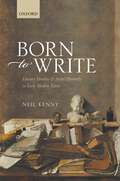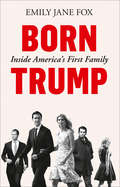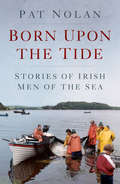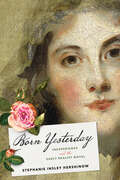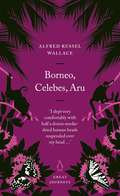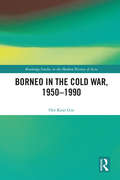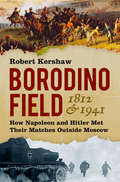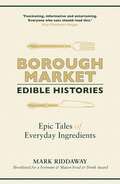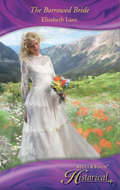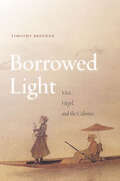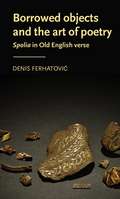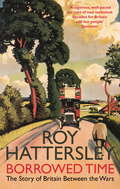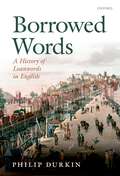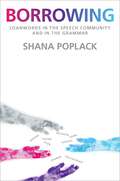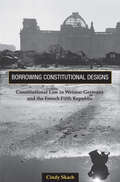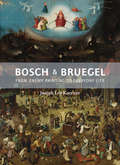- Table View
- List View
Born to Write: Literary Families and Social Hierarchy in Early Modern France
by Neil KennyIt is easy to forget how deeply embedded in social hierarchy was the literature and learning that has come down to us from the early modern European world. From fiction to philosophy, from poetry to history, works of all kinds emerged from and through the social hierarchy that was a fundamental fact of everyday life. Paying attention to it changes how we might understand and interpret the works themselves, whether canonical and familiar or largely forgotten. But a second, related fact is much overlooked too: works also often emanated from families, not just from individuals. Families were driving forces in the production—that is, in the composing, editing, translating, or publishing—of countless works. Relatives collaborated with each other, edited each other, or continued the unfinished works of deceased family members; some imitated or were inspired by the works of long-dead relatives. The reason why this second fact (about families) is connected to the first (about social hierarchy) is that families were in the period a basic social medium through which social status was claimed, maintained, threatened, or lost. So producing literary works was one of the many ways in which families claimed their place in the social world. The process was however often fraught, difficult, or disappointing. If families created works as a form of socio-cultural legacy that might continue to benefit their future members, not all members benefited equally; women sometimes produced or claimed the legacy for themselves, but they were often sidelined from it. Relatives sometimes disagreed bitterly about family history, identity (not least religious), and so about the picture of themselves and their family that they wished to project more widely in society through their written works, whether printed or manuscript. So although family was a fundamental social medium out of which so many works emerged, that process could be conflictual as well as harmonious. The intertwined role of family and social hierarchy within literary production is explored in this book through the case of France, from the late fifteenth to the mid-seventeenth century. Some families are studied here in detail, such as that of the most widely read French poet of the age, Clément Marot. But the extent of this phenomenon is quantified too: some two hundred families are identified as each containing more than one literary producer, and in the case of one family an extraordinary twenty-seven.
Born Trump: Inside America's First Family
by Emily Jane FoxAs a writer at Vanity Fair covering the Trump family, Emily Jane Fox has spent the last year doing a deep dive into the lives of the President’s children. Born Trump is the explosive narrative of her findings as an insider within the most influential family in America.
Born Upon the Tide: Stories of Irish Men of the Sea
by Pat NolanThe coastline of Ireland, from the rugged fjords of the west to the steely waters of the north, is infused with memories of loss, sadness and beauty. In this work, maritime historian and author Pat Nolan speaks to the fishermen, boatbuilders and sailors whose lives have been shaped by these seas. What emerges is a picture of a way of life that has changed dramatically in recent years, and yet retains a consistency as timeless as the returning tide.
Born Yesterday: Inexperience and the Early Realist Novel
by Stephanie Insley HershinowBetween the emergence of the realist novel in the early eighteenth century and the novel's subsequent alignment with self-improvement a century later lies a significant moment when novelistic characters were unlikely to mature in any meaningful way. That adolescent protagonists poised on the cusp of adulthood resisted a headlong tumble into maturity through the workings of plot reveals a curious literary and philosophical counter-tradition in the history of the novel. Stephanie Insley Hershinow's Born Yesterday shows how the archetype of the early realist novice reveals literary character tout court. Through new readings of canonical novels by Samuel Richardson, Henry Fielding, Horace Walpole, Ann Radcliffe, Frances Burney, and Jane Austen, Hershinow severs the too-easy tie between novelistic form and character formation, a conflation, she argues, of Bild with Bildung. A pop-culture-infused epilogue illustrates the influence of the eighteenth-century novice, as embodied by Austen's Emma, in the 1995 film Clueless, as well as in dystopian YA works like The Hunger Games. Drawing on bold close readings, Born Yesterday alters the landscape of literary historical eighteenth-century studies and challenges some of novel theory's most well-worn assumptions.
Born Yesterday: Inexperience and the Early Realist Novel
by Stephanie Insley HershinowBetween the emergence of the realist novel in the early eighteenth century and the novel's subsequent alignment with self-improvement a century later lies a significant moment when novelistic characters were unlikely to mature in any meaningful way. That adolescent protagonists poised on the cusp of adulthood resisted a headlong tumble into maturity through the workings of plot reveals a curious literary and philosophical counter-tradition in the history of the novel. Stephanie Insley Hershinow's Born Yesterday shows how the archetype of the early realist novice reveals literary character tout court. Through new readings of canonical novels by Samuel Richardson, Henry Fielding, Horace Walpole, Ann Radcliffe, Frances Burney, and Jane Austen, Hershinow severs the too-easy tie between novelistic form and character formation, a conflation, she argues, of Bild with Bildung. A pop-culture-infused epilogue illustrates the influence of the eighteenth-century novice, as embodied by Austen's Emma, in the 1995 film Clueless, as well as in dystopian YA works like The Hunger Games. Drawing on bold close readings, Born Yesterday alters the landscape of literary historical eighteenth-century studies and challenges some of novel theory's most well-worn assumptions.
Borneo, Celebes, Aru
by Alfred Russel WallaceRacked with fever, virtually broke and earning a precarious living through sending back to London the plumes of beautiful birds, Wallace (1823-1913) ultimately became one of the most heroic and admirable of all scientist-explorers. Whether living with Hill Dyaks or hunting Orang-Utans or sailing on a junk to the unbelievably remote Aru islands, Wallace opens our eyes to a now long vanished world.Great Journeys allows readers to travel both around the planet and back through the centuries – but also back into ideas and worlds frightening, ruthless and cruel in different ways from our own. Few reading experiences can begin to match that of engaging with writers who saw astounding things: Great civilisations, walls of ice, violent and implacable jungles, deserts and mountains, multitudes of birds and flowers new to science. Reading these books is to see the world afresh, to rediscover a time when many cultures were quite strange to each other, where legends and stories were treated as facts and in which so much was still to be discovered.
Borneo in the Cold War, 1950-1990 (Routledge Studies in the Modern History of Asia)
by Keat Gin OoiAlthough by about 1950 both British Borneo, including the protected sultanate of Brunei, and Indonesian Borneo seemed settled under their different regimes and well on the way to post-war reconstruction and economic development, the upheavals which affected Southeast and East Asia during the Cold War period also deeply affected Borneo. Besides the impact of the Korean and Vietnam Wars and the Malayan Emergency and communist uprisings in other Southeast Asian states, there was within Borneo the attempted communist takeover of Sarawak from the 1950s, a failed coup d’état in Brunei in 1962, Sukarno’s Konfrontasi (confrontation) with Malaysia, and the horrific purge of Leftists and ethnic Chinese in the late 1960s. This book details these momentous events and assesses their impact on Borneo and its people. It is a sequel to the author’s earlier books The Japanese Occupation of Borneo, 1941-1945 (2011) and Post-War Borneo, 1945-1950: Nationalism, Empire, and State-Building (2013), collectively a trilogy.
Borneo in the Cold War, 1950-1990 (Routledge Studies in the Modern History of Asia)
by Keat Gin OoiAlthough by about 1950 both British Borneo, including the protected sultanate of Brunei, and Indonesian Borneo seemed settled under their different regimes and well on the way to post-war reconstruction and economic development, the upheavals which affected Southeast and East Asia during the Cold War period also deeply affected Borneo. Besides the impact of the Korean and Vietnam Wars and the Malayan Emergency and communist uprisings in other Southeast Asian states, there was within Borneo the attempted communist takeover of Sarawak from the 1950s, a failed coup d’état in Brunei in 1962, Sukarno’s Konfrontasi (confrontation) with Malaysia, and the horrific purge of Leftists and ethnic Chinese in the late 1960s. This book details these momentous events and assesses their impact on Borneo and its people. It is a sequel to the author’s earlier books The Japanese Occupation of Borneo, 1941-1945 (2011) and Post-War Borneo, 1945-1950: Nationalism, Empire, and State-Building (2013), collectively a trilogy.
Borodino 1812: Napoleon’s great gamble (Campaign)
by Peter Dennis Philip HaythornthwaiteThe battle of Borodino was one of the greatest encounters in European history, and one of the largest and most sanguinary in the Napoleonic Wars. Following the breakdown of relations between Russia and France, Napoleon assembled a vast Grande Armée drawn from the many states within the French sphere of influence. They crossed the river Neimen and entered Russian territory in June 1812 with the aim of inflicting a sharp defeat on the Tsar's forces and bringing the Russians back into line. In a bloody battle of head-on attacks and desperate counter-attacks in the village of Borodino on 7 September 1812, both sides lost about a third of their men, with the Russians forced to withdraw and abandon Moscow to the French. However, the Grande Armée was harassed by Russian troops all the way back and was destroyed by the retreat. The greatest army Napoleon had ever commanded was reduced to a shadow of frozen, starving fugitives. This title will cover the events of Napoleon's disastrous Russian campaign of 1812 in its entirety, with the set-piece battle of Borodino proving the focal point of the book.
Borodino 1812: Napoleon’s great gamble (Campaign #246)
by Peter Dennis Philip HaythornthwaiteThe battle of Borodino was one of the greatest encounters in European history, and one of the largest and most sanguinary in the Napoleonic Wars. Following the breakdown of relations between Russia and France, Napoleon assembled a vast Grande Armée drawn from the many states within the French sphere of influence. They crossed the river Neimen and entered Russian territory in June 1812 with the aim of inflicting a sharp defeat on the Tsar's forces and bringing the Russians back into line. In a bloody battle of head-on attacks and desperate counter-attacks in the village of Borodino on 7 September 1812, both sides lost about a third of their men, with the Russians forced to withdraw and abandon Moscow to the French. However, the Grande Armée was harassed by Russian troops all the way back and was destroyed by the retreat. The greatest army Napoleon had ever commanded was reduced to a shadow of frozen, starving fugitives. This title will cover the events of Napoleon's disastrous Russian campaign of 1812 in its entirety, with the set-piece battle of Borodino proving the focal point of the book.
Borodino Field 1812 & 1941: How Napoleon and Hitler Met Their Matches Outside Moscow
by Robert KershawThe Battle of Borodino resonates with the patriotic soul of Mother Russia. The epic confrontation in September 1812 was the single bloodiest day of the Napoleonic Wars, leaving France’s Grande Armée limping to the gates of Moscow and on to catastrophe in snow and ice. Generations later, in October 1941, an equally bitter battle was fought at Borodino. This time Hitler's SS and Panzers came up against elite Siberian troops defending Stalin's Moscow. Remarkably, both conflicts took place in the same woods and gullies that follow the sinuous line of the Koloch River. Borodino Field relates the gruelling experience of the French army in Russia, juxtaposed with the personal accounts, diaries and letters of SS and Panzer soldiers during the Second World War. Acclaimed historian Robert Kershaw draws on previously untapped archives to narrate the odyssey of soldiers who marched along identical tracks and roads on the 1,000-kilometre route to Moscow, and reveals the astonishing parallels and contrasts between two battles fought on Russian soil, over one hundred years apart.
Borough Market: Epic tales of everyday ingredients
by Mark RiddawayAs a nation of food-lovers we have been munching on fruit and veg, drinking tea and coffee and adorning our dishes with oils and spices for generations, but have you ever stopped to wonder how our most beloved foods came to be the way they are now?In this series of enlightening and highly entertaining essays, award-winning food writer Mark Riddaway travels back through the centuries to tell the fascinating, surprising and often downright bizarre stories of some of the everyday ingredients found at London's Borough Market.Discover how the strawberries we eat today had their roots in a clandestine trip to South America by a French spy whose surname happened to be Strawberry, why three-quarters of Britain's late-18th-century intake of tea was sold on the black market, and what Sigmund Freud found so fascinating about eel genitalia.From the humble apples and onions that we've grown on these shores for centuries, to more exotic ingredients like cinnamon and bananas that travel from across the world to finesse our food, Borough Market: Edible Histories offers a chance to digest the charming stories behind every last morsel.
The Borrowed Bride: The Hand-me-down Bride The Bride Wore Britches Something Borrowed, Something True (Mills And Boon Historical Ser.)
by Elizabeth LaneIndulge your fantasies of delicious Regency Rakes, fierce Viking warriors and rugged Highlanders. Be swept away into a world of intense passion, lavish settings and romance that burns brightly through the centuries ‘We’re going to have a child. You need to come home so we can get married. ’
Borrowed Light: Vico, Hegel, and the Colonies
by Timothy BrennanA critical revaluation of the humanist tradition, Borrowed Light makes the case that the 20th century is the "anticolonial century." The sparks of concerted resistance to colonial oppression were ignited in the gathering of intellectual malcontents from all over the world in interwar Europe. Many of this era's principal figures were formed by the experience of revolution on Europe's semi-developed Eastern periphery, making their ideas especially pertinent to current ideas about autonomy and sovereignty. Moreover, the debates most prominent then—human vs. inhuman, religions of the book vs. oral cultures, the authoritarian state vs. the representative state and, above all, scientific rationality vs. humanist reason—remain central today. Timothy Brennan returns to the scientific Enlightenment of the 17th century and its legacies. In readings of the showdown between Spinoza and Vico, Hegel's critique of liberalism, and Nietzsche's antipathy towards the colonies and social democracy, Brennan identifies the divergent lines of the first anticolonial theory—a literary and philosophical project with strong ties to what we now call Marxism. Along the way, he assesses prospects for a renewal of the study of imperial culture.
Borrowed objects and the art of poetry: <i>Spolia</i> in Old English verse (Manchester Medieval Literature and Culture)
by Denis FerhatovicThis study examines Exeter riddles, Anglo-Saxon biblical poems (Exodus, Andreas, Judith) and Beowulf in order to uncover the poetics of spolia, an imaginative use of recycled fictional artefacts to create sites of metatextual reflection. Old English poetry famously lacks an explicit ars poetica. This book argues that attention to particularly charged moments within texts – especially those concerned with translation, transformation and the layering of various pasts – yields a previously unrecognised means for theorising Anglo-Saxon poetic creativity. Borrowed objects and the art of poetry works at the intersections of materiality and poetics, balancing insights from thing theory and related approaches with close readings of passages from Old English texts.
Borrowed objects and the art of poetry: <i>Spolia</i> in Old English verse (Manchester Medieval Literature and Culture)
by Denis FerhatovicThis study examines Exeter riddles, Anglo-Saxon biblical poems (Exodus, Andreas, Judith) and Beowulf in order to uncover the poetics of spolia, an imaginative use of recycled fictional artefacts to create sites of metatextual reflection. Old English poetry famously lacks an explicit ars poetica. This book argues that attention to particularly charged moments within texts – especially those concerned with translation, transformation and the layering of various pasts – yields a previously unrecognised means for theorising Anglo-Saxon poetic creativity. Borrowed objects and the art of poetry works at the intersections of materiality and poetics, balancing insights from thing theory and related approaches with close readings of passages from Old English texts.
Borrowed Time: The Story of Britain Between the Wars
by Roy HattersleyCalled an uneasy peace, the twenty years between the wars were a time of turmoil - Britain saw a general strike and the worst economic crisis in its history, armed rebellion in Ireland and open revolt in India, a Prime Minister's resignation and the King's abdication. Crisis followed crisis until Britain was engulfed in the Second World War - a catastrophe that could have been foreseen, possibly even prevented. But there were also moments of triumph: England regained the Ashes and Britain ran to glory in the 'Chariots of Fire' Olympic Games; the BBC was born and became the envy of the free world; there was a renaissance in poetry, sculpture of genius, and cinema lightened the darkness for millions. However it is the politicians who failed who have really come to personify the interwar years - in particular Ramsey MacDonald and Stanley Baldwin. Both prime ministers were better men than history allows. And Winston Churchill? Right or wrong, success or failure, he is the irrepressible force in what he called the 'years for the locusts to eat'. Hattersley's assessment of this doomed era is illuminating, entertaining and bold.
Borrowed Words: A History of Loanwords in English
by Philip DurkinThe rich variety of the English vocabulary reflects the vast number of words it has taken from other languages. These range from Latin, Greek, Scandinavian, Celtic, French, Italian, Spanish, and Russian to, among others, Hebrew, Maori, Malay, Chinese, Hindi, Japanese, andYiddish. Philip Durkin's full and accessible history reveals how, when, and why. He shows how to discover the origins of loanwords, when and why they were adopted, and what happens to them once they have been. The long documented history of English includes contact with languages in a variety of contexts, including: the dissemination of Christian culture in Latin in Anglo-Saxon England, and the interactions of French, Latin, Scandinavian, Celtic, and English during the Middle Ages; exposure to languages throughout the world during the colonial era; and the effects of using English as an international language of science. Philip Durkin describes these and other historical inputs, introducing the approaches each requires, from the comparative method for the earliest period to documentary and corpus research in the modern. The discussion is illustrated at every point with examples taken from a variety of different sources. The framework Dr Durkin develops can be used to explore lexical borrowing in any language. This outstanding book is for everyone interested in English etymology and in loanwords more generally. It will appeal to a wide general public and at the same time offers a valuable reference for scholars and students of the history of English.
Borrowing: Loanwords in the Speech Community and in the Grammar
by Shana PoplackStudies of bilingual behavior have been proliferating for decades, yet short shrift has been given to its major manifestation, the incorporation of words from one language into the discourse of another. This volume redresses that imbalance by going straight to the source: bilingual speakers in their social context. Building on more than three decades of original research based on vast quantities of spontaneous performance data and a highly ramified analytical apparatus, Shana Poplack characterizes the phenomenon of lexical borrowing in the speech community and in the grammar, both synchronically and diachronically. In contrast to most other treatments, which deal with the product of borrowing (if they consider it at all), this book examines the process: how speakers go about incorporating foreign items into their bilingual discourse; how they adapt them to recipient-language grammatical structure; how these forms diffuse across speakers and communities; how long they persist in real time; and whether they change over the duration. Attacking some of the most contentious issue in language mixing research empirically, it tests hypotheses about established loanwords, nonce borrowings and code-switches on a wealth of unique datasets on typologically similar and distinct language pairs. A major focus is the detailed analysis of integration: the principal mechanism underlying the borrowing process. Though the shape the borrowed form assumes may be colored by community convention, Poplack shows that the act of transforming donor-language elements into native material is universal. Emphasis on actual speaker behavior coupled with strong standards of proof, including data-driven reports of rates of occurrence, conditioning of variant choice and measures of statistical significance, make Borrowing an indispensable reference on language contact and bilingual behavior.
BORROWING C: Loanwords in the Speech Community and in the Grammar
by Shana PoplackStudies of bilingual behavior have been proliferating for decades, yet short shrift has been given to its major manifestation, the incorporation of words from one language into the discourse of another. This volume redresses that imbalance by going straight to the source: bilingual speakers in their social context. Building on more than three decades of original research based on vast quantities of spontaneous performance data and a highly ramified analytical apparatus, Shana Poplack characterizes the phenomenon of lexical borrowing in the speech community and in the grammar, both synchronically and diachronically. In contrast to most other treatments, which deal with the product of borrowing (if they consider it at all), this book examines the process: how speakers go about incorporating foreign items into their bilingual discourse; how they adapt them to recipient-language grammatical structure; how these forms diffuse across speakers and communities; how long they persist in real time; and whether they change over the duration. Attacking some of the most contentious issue in language mixing research empirically, it tests hypotheses about established loanwords, nonce borrowings and code-switches on a wealth of unique datasets on typologically similar and distinct language pairs. A major focus is the detailed analysis of integration: the principal mechanism underlying the borrowing process. Though the shape the borrowed form assumes may be colored by community convention, Poplack shows that the act of transforming donor-language elements into native material is universal. Emphasis on actual speaker behavior coupled with strong standards of proof, including data-driven reports of rates of occurrence, conditioning of variant choice and measures of statistical significance, make Borrowing an indispensable reference on language contact and bilingual behavior.
Borrowing Constitutional Designs: Constitutional Law in Weimar Germany and the French Fifth Republic
by Cindy SkachAfter the collapse of communism, some thirty countries scrambled to craft democratic constitutions. Surprisingly, the constitutional model they most often chose was neither the pure parliamentary model found in most of Western Europe at the time, nor the presidential model of the Americas. Rather, it was semi-presidentialism--a rare model known more generally as the "French type." This constitutional model melded elements of pure presidentialism with those of pure parliamentarism. Specifically, semi-presidentialism combined a popularly elected head of state with a head of government responsible to a legislature. Borrowing Constitutional Designs questions the hasty adoption of semi-presidentialism by new democracies. Drawing on rich case studies of two of the most important countries for European politics in the twentieth century--Weimar Germany and the French Fifth Republic--Cindy Skach offers the first theoretically focused, and historically grounded, analysis of semi-presidentialism and democracy. She demonstrates that constitutional choice matters, because under certain conditions, semi-presidentialism structures incentives that make democratic consolidation difficult or that actually contribute to democratic collapse. She offers a new theory of constitutional design, integrating insights from law and the social sciences. In doing so, Skach challenges both democratic theory and democratic practice. This book will be welcomed not only by scholars and practitioners of constitutional law but also by those in fields such as comparative politics, European politics and history, and international and public affairs.
Borrowing Constitutional Designs: Constitutional Law in Weimar Germany and the French Fifth Republic (PDF)
by Cindy SkachAfter the collapse of communism, some thirty countries scrambled to craft democratic constitutions. Surprisingly, the constitutional model they most often chose was neither the pure parliamentary model found in most of Western Europe at the time, nor the presidential model of the Americas. Rather, it was semi-presidentialism--a rare model known more generally as the "French type." This constitutional model melded elements of pure presidentialism with those of pure parliamentarism. Specifically, semi-presidentialism combined a popularly elected head of state with a head of government responsible to a legislature. Borrowing Constitutional Designs questions the hasty adoption of semi-presidentialism by new democracies. Drawing on rich case studies of two of the most important countries for European politics in the twentieth century--Weimar Germany and the French Fifth Republic--Cindy Skach offers the first theoretically focused, and historically grounded, analysis of semi-presidentialism and democracy. She demonstrates that constitutional choice matters, because under certain conditions, semi-presidentialism structures incentives that make democratic consolidation difficult or that actually contribute to democratic collapse. She offers a new theory of constitutional design, integrating insights from law and the social sciences. In doing so, Skach challenges both democratic theory and democratic practice. This book will be welcomed not only by scholars and practitioners of constitutional law but also by those in fields such as comparative politics, European politics and history, and international and public affairs.
Bosch and Bruegel: From Enemy Painting to Everyday Life (PDF)
by Joseph Leo KoernerIn this visually stunning and much anticipated book, acclaimed art historian Joseph Koerner casts the paintings of Hieronymus Bosch and Pieter Bruegel in a completely new light, revealing how the painting of everyday life was born from what seems its polar opposite: the depiction of an enemy hell-bent on destroying us.Supreme virtuoso of the bizarre, diabolic, and outlandish, Bosch embodies the phantasmagorical force of painting, while Bruegel, through his true-to-life landscapes and frank depictions of peasants, is the artistic avatar of the familiar and ordinary. But despite their differences, the works of these two artists are closely intertwined. Bruegel began his career imitating Bosch's fantasies, and it was Bosch who launched almost the whole repertoire of later genre painting. But Bosch depicts everyday life in order to reveal it as an alluring trap set by a metaphysical enemy at war with God, whereas Bruegel shows this enemy to be nothing but a humanly fabricated mask. Attending closely to the visual cunning of these two towering masters, Koerner uncovers art history’s unexplored underside: the image itself as an enemy.An absorbing study of the dark paradoxes of human creativity, Bosch and Bruegel is also a timely account of how hatred can be converted into tolerance through the agency of art. It takes readers through all the major paintings, drawings, and prints of these two unforgettable artists—including Bosch’s notoriously elusive Garden of Earthly Delights, which forms the core of this historical tour de force. Elegantly written and abundantly illustrated, the book is based on Koerner’s A. W. Mellon Lectures in the Fine Arts, a series given annually at the National Gallery of Art, Washington.
Bosch and Bruegel: From Enemy Painting to Everyday Life (PDF)
by Joseph Leo KoernerIn this visually stunning and much anticipated book, acclaimed art historian Joseph Koerner casts the paintings of Hieronymus Bosch and Pieter Bruegel in a completely new light, revealing how the painting of everyday life was born from what seems its polar opposite: the depiction of an enemy hell-bent on destroying us.Supreme virtuoso of the bizarre, diabolic, and outlandish, Bosch embodies the phantasmagorical force of painting, while Bruegel, through his true-to-life landscapes and frank depictions of peasants, is the artistic avatar of the familiar and ordinary. But despite their differences, the works of these two artists are closely intertwined. Bruegel began his career imitating Bosch's fantasies, and it was Bosch who launched almost the whole repertoire of later genre painting. But Bosch depicts everyday life in order to reveal it as an alluring trap set by a metaphysical enemy at war with God, whereas Bruegel shows this enemy to be nothing but a humanly fabricated mask. Attending closely to the visual cunning of these two towering masters, Koerner uncovers art history’s unexplored underside: the image itself as an enemy.An absorbing study of the dark paradoxes of human creativity, Bosch and Bruegel is also a timely account of how hatred can be converted into tolerance through the agency of art. It takes readers through all the major paintings, drawings, and prints of these two unforgettable artists—including Bosch’s notoriously elusive Garden of Earthly Delights, which forms the core of this historical tour de force. Elegantly written and abundantly illustrated, the book is based on Koerner’s A. W. Mellon Lectures in the Fine Arts, a series given annually at the National Gallery of Art, Washington.
Bosch and Bruegel: From Enemy Painting to Everyday Life (PDF)
by Joseph Leo KoernerIn this visually stunning and much anticipated book, acclaimed art historian Joseph Koerner casts the paintings of Hieronymus Bosch and Pieter Bruegel in a completely new light, revealing how the painting of everyday life was born from what seems its polar opposite: the depiction of an enemy hell-bent on destroying us.Supreme virtuoso of the bizarre, diabolic, and outlandish, Bosch embodies the phantasmagorical force of painting, while Bruegel, through his true-to-life landscapes and frank depictions of peasants, is the artistic avatar of the familiar and ordinary. But despite their differences, the works of these two artists are closely intertwined. Bruegel began his career imitating Bosch's fantasies, and it was Bosch who launched almost the whole repertoire of later genre painting. But Bosch depicts everyday life in order to reveal it as an alluring trap set by a metaphysical enemy at war with God, whereas Bruegel shows this enemy to be nothing but a humanly fabricated mask. Attending closely to the visual cunning of these two towering masters, Koerner uncovers art history’s unexplored underside: the image itself as an enemy.An absorbing study of the dark paradoxes of human creativity, Bosch and Bruegel is also a timely account of how hatred can be converted into tolerance through the agency of art. It takes readers through all the major paintings, drawings, and prints of these two unforgettable artists—including Bosch’s notoriously elusive Garden of Earthly Delights, which forms the core of this historical tour de force. Elegantly written and abundantly illustrated, the book is based on Koerner’s A. W. Mellon Lectures in the Fine Arts, a series given annually at the National Gallery of Art, Washington.
